1) The structure and composition of the Earth’s atmosphere.
2) Geopotential and barometric altitude.
The Earth’s atmosphere is a gaseous shell with solid and liquid particles in constant motion relative to the Earth’s surface. About half of the total mass of the atmosphere is located in its lower boundary.
The lower boundary of the atmosphere, also known as the underlying surface, is the Earth’s surface that interacts with the atmosphere.
Unlike water, atmospheric air is capable of compression and therefore its density decreases. The atmosphere does not have a distinct boundary, but rather gradually transitions into interplanetary space, which contains approximately 100 particles (protons and electrons) per cubic centimeter. This concentration is observed at altitudes of 20-30 thousand, hence these altitudes are referred to as the upper boundary of the atmosphere.
The atmosphere is segmented into layers based on the distribution of air temperature with altitude.
The distribution of air temperature with altitude is known as the temperature profile of the atmosphere. Depending on the stratification, there are five main layers and four transitional layers that can be distinguished.

The Troposphere – is the layer of the atmosphere that extends from the Earth’s surface to the tropopause. It is characterized by a decrease in air temperature as altitude increases.
The Stratosphere- is located above the tropopause and is characterized by an increase in air temperature with altitude.
The Mesosphere- is the layer of the atmosphere where temperature decreases with altitude and can reach as low as -110 degrees.
The Thermosphere- is the warmest part of the atmosphere.
The Exosphere- is the outermost and most rarefied layer of the Earth’s upper atmosphere.
The Tropopause- is a transitional layer between the troposphere and the stratosphere, ranging in thickness from a few hundred meters to 2km.
The Stratopause- is the atmospheric boundary layer between the stratosphere and the mesosphere, located at an altitude of 50-55 km.
MESOPAUSE The mesopause is a transitional layer between the mesosphere and the thermosphere that can be found at an altitude of 80-90 km. It acts as a boundary between these two atmospheric regions.
Thermopause The thermopause is the upper layer of the planet’s atmosphere, located above the thermosphere. This region is characterized by a transition to a constant temperature. Beyond the thermopause lies the exosphere.
Standard Atmosphere
In the field of aviation, the Standard Atmosphere is widely utilized. It serves as a benchmark against which the physical state of the actual atmosphere can be compared. The Standard Atmosphere finds applications in various areas:
– in calculations and aircraft design
– in the processing of meteorological observation data
– in assessing the impact of the real atmosphere on the flight-operational characteristics of an aircraft
– when utilizing the barometric method for determining altitude
2) The concept of geopotential. Geopotential and barometric altitude.
The idea of geopotential is that it represents the amount of work required to lift a unit mass from sea level to a specific point in the atmosphere, taking into account the force of gravity. It essentially measures the potential energy of an air particle at a given location in the atmosphere. (It is assumed that geopotential at sea level is 0)
Geopotential height:

Geopotential height is measured in units of geopotential meters. One decameter (dam) is equal to 10 geopotential meters. A geopotential meter (gp.m.) is the amount of work required to raise a unit mass to a height of 1 meter at the standard acceleration of gravity. It is equal to 9.80665 m^2/c^2. (typically expressed in geopotential decameters (dam), where 1 dam = 10 gp.m). Aircraft flights are conducted at specific altitudes known as echelons, which are measured using a barometric altimeter. Barometric altitude or pressure altitude refers to the altitude in the Standard Atmosphere at which the air pressure matches the actual pressure measured by a barometric altimeter during flight. In simpler terms, barometric altitude represents the atmospheric pressure converted to the corresponding absolute altitude in the Standard Atmosphere.
The climate and the existence of all living things on our planet are made possible by a protective layer of gases. More information about this will be provided in the following paragraphs.
Layers of the Atmosphere
Scientists refer to the air envelope surrounding our planet as the atmosphere. This term literally translates to “vapor sphere”.
As we move upwards from the Earth’s surface, the composition of the atmosphere becomes less uniform and varies in terms of gas and water vapor content. The outermost layers of the atmosphere, bordering outer space, are the least dense and contain minimal amounts of gases.
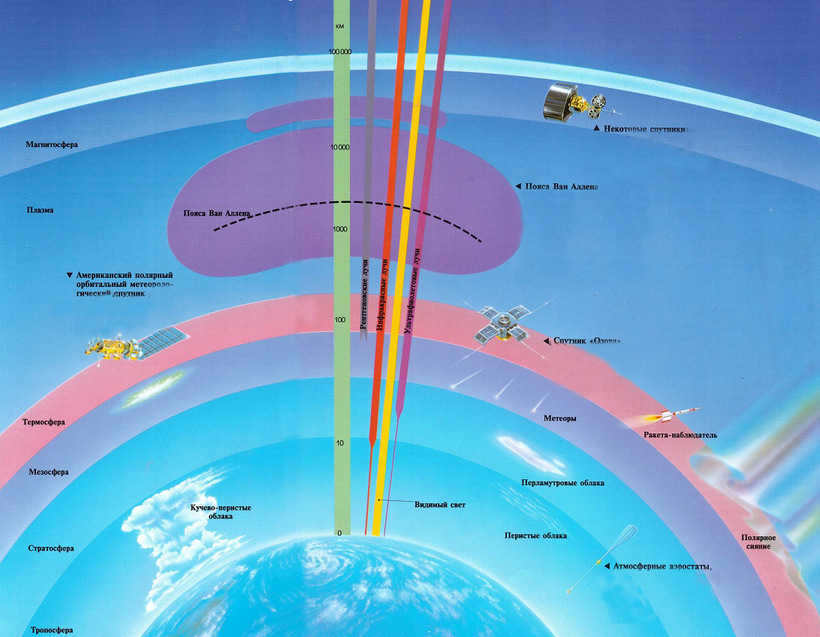
Considering this statement, the atmosphere is divided into distinct layers:
- The first and most abundant layer of the atmosphere is known as the troposphere (up to 10 km);
- Above the troposphere, between 10 and 50 km, lies the next layer, called the stratosphere;
- Between 50 and 100 km, we find the mesosphere;
- Extending up to 1000 km above the Earth’s surface is the thermosphere;
- The outermost layer of the atmosphere is the exosphere.
This unique arrangement of the atmosphere serves as a protective shield for all life on Earth, shielding it from the detrimental effects of outer space.
Troposphere
It can be easily assumed that the majority of gases, including vapor, gather in the initial, lower layer – the troposphere.
The troposphere itself is divided into three layers of air masses friction: the first – up to a height of 1-2 km, the second – ranging from 2 to 6 km, and the third – exceeding 6 km.
The first layer experiences seasonal fluctuations in temperature, the second layer is where clouds form, and the third layer consists of air masses with a consistent direction of airflow, which is formed by atmospheric fronts.
Tropospheric Water Vapor
In the troposphere, there exists a vital gas composition for all life on Earth: 78% nitrogen and 20.93% oxygen. The rest of the tropospheric air is comprised of various other gases, such as carbon, hydrogen, helium, and more.

In the troposphere, the majority of atmospheric oxygen exists in the form of water vapor, accounting for approximately 15 thousand cubic meters. Due to the continuous water cycle, the composition of vapor in this layer remains relatively consistent. Hence, the troposphere contains the highest concentration of water vapor.

According to modern scientific classification, the atmosphere can be divided into several distinct parts:
1. The lowermost layer of the atmosphere, which is where humans reside.
2. The troposphere, which is the densest and most extensive part of the atmosphere.
3. The stratosphere, where the air is relatively thin and temperatures vary.
4. The mesosphere, which is responsible for major atmospheric heat exchange processes.
5. The Karman line, which marks the boundary between Earth and outer space, although the atmosphere extends beyond it.
6. The thermosphere, which experiences intense solar radiation and radiation.
7. The exosphere, the outermost part of the atmosphere with extremely thin air that gradually transitions into outer space.

It is my belief that every individual, on at least one occasion during their lifetime, gazing up at the heavens, has pondered over the barriers that separate us from the immense cosmos, the shielding mechanism that safeguards us from harmful ultraviolet radiation, and the protective cover that defends us against extreme heat and cold. All of these crucial roles are fulfilled by the atmosphere, which can be described as the gaseous envelope surrounding our planet.

An overview of the atmosphere
What about its form? The lower layers of the atmosphere mimic the Earth’s shape, which is ellipsoidal, while the upper layers have a “pear-like” shape due to the flattening on the side facing the Sun and stretching in the opposite direction caused by the solar wind.
The total mass of the atmosphere is 5.2 x 10^15 tons, with half of its mass concentrated within the layer up to 5.3 km.

Structure in Vertical Direction
Thus, based on variations in temperature, chemical composition, gas state, and matter structure, the atmosphere can be divided into the following primary layers:
- troposphere – which extends up to 8-17 km;
- stratosphere – which extends up to 50-55 km;
- mesosphere – which extends up to 80-85 km;
- thermosphere – which extends up to 1000 km;
- exosphere – which extends up to 10,000 km.
Interestingly, there are transitional zones between these layers known as the tropopause, stratopause, mesopause, and thermopause.
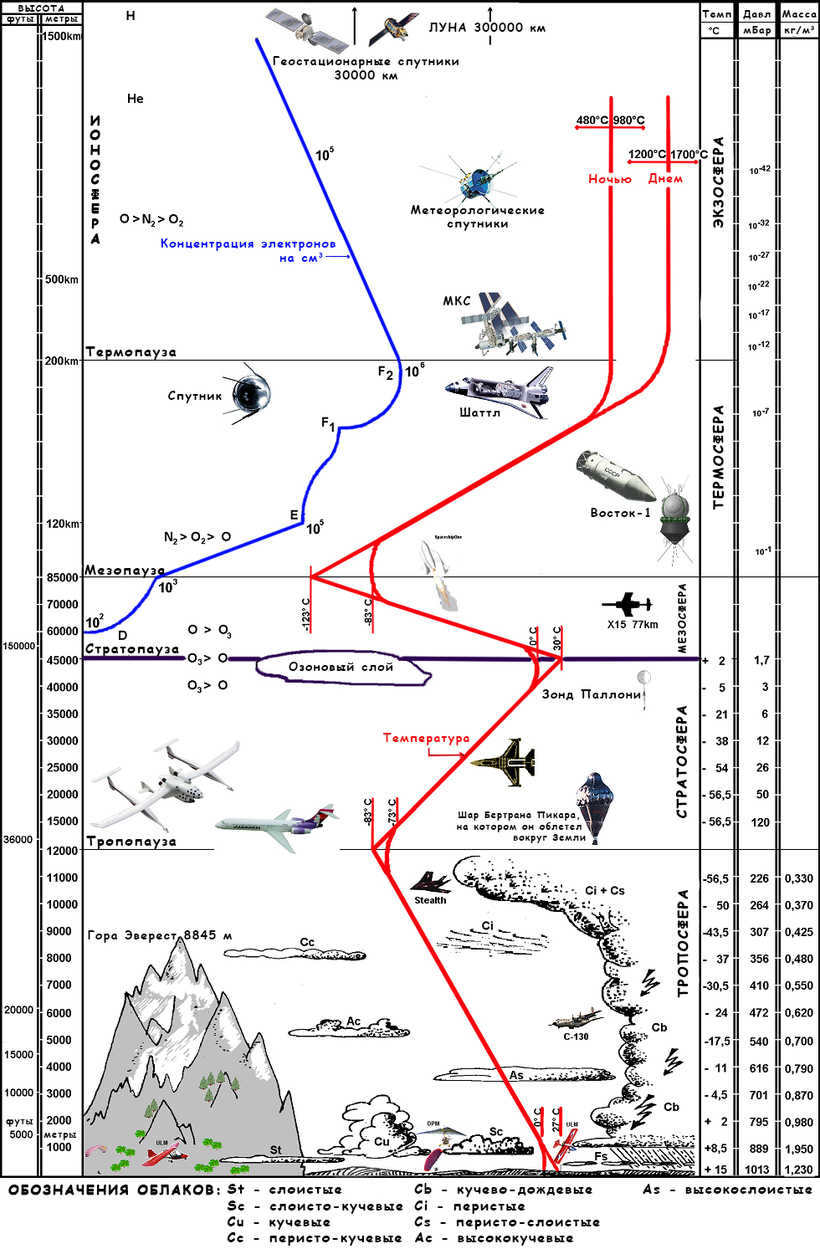
Concise Overview of Each Layer
The troposphere comprises more than 80% of the atmosphere’s mass, serving as the primary zone for cloud formation, wind movement, and precipitation occurrence.
The stratosphere encompasses approximately 90% of the ozone layer, resulting in significant temperature fluctuations.
In the mesosphere, temperatures plummet to -80°C, while the gas composition remains constant.
The thermosphere is characterized by an extremely thin atmosphere, with even the lower portion having a density 10,000 times lesser than that at the Earth’s surface. Temperatures become imperceptible, and this region is renowned for the occurrence of the aurora borealis.
The exosphere consists of particles that travel at high velocities and possess the ability to escape into outer space.
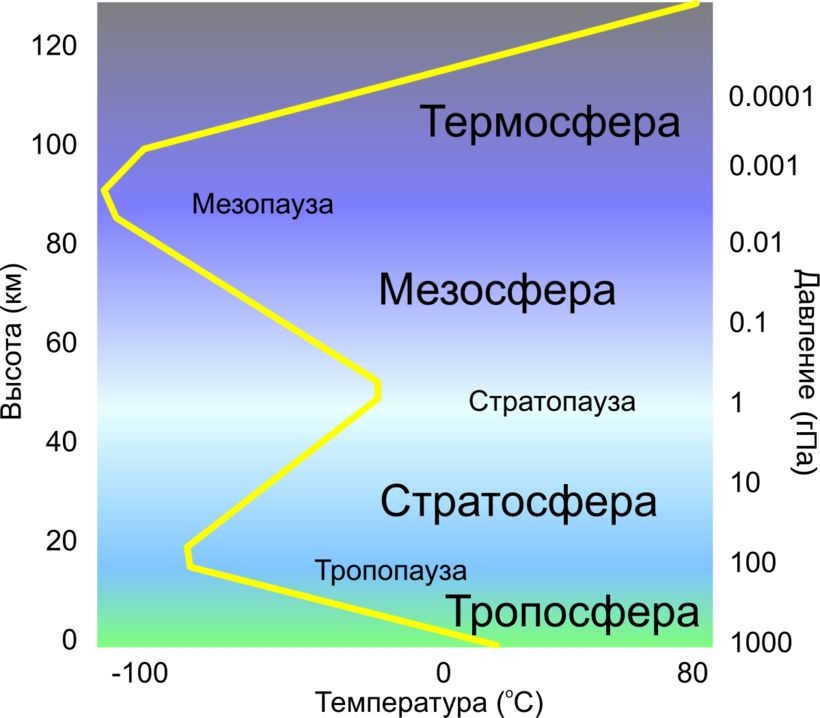
Researching the Atmosphere
Meteorological stations study the lower layers of the atmosphere. Many of these stations are automated, and there are also weather ships.
Radiosondes and air sounding are used to study layers up to 30-40 km. The stratosphere, mesosphere, and thermosphere are investigated with the help of meteorological and geophysical rockets. Satellites are utilized for studying high altitudes.
The atmosphere, which is the gas envelope surrounding our planet Earth, is divided into five main layers. These layers begin at the surface of the planet, starting from sea level (sometimes below), and extend into outer space in the following order:
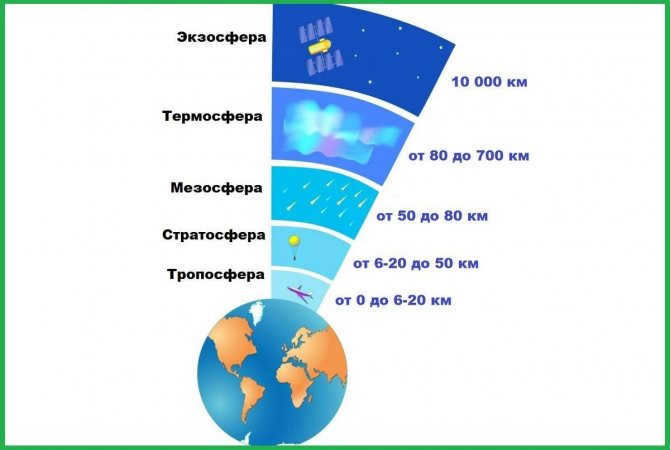
Here is a representation of the primary layers that make up Earth’s atmosphere.
Interspersed between these five primary layers are transitional areas known as “pauses,” where variations in temperature, composition, and air density take place. When combined with the pauses, Earth’s atmosphere consists of a total of nine layers.
Where the weather happens: the troposphere

The troposphere, which is the closest layer of the atmosphere to the Earth’s surface, is where most of our weather occurs. It extends several kilometers above the surface and is responsible for the changes we experience on a daily basis. The name troposphere comes from the Greek word “tropos” which means “change”. It is an apt name, as this layer is constantly changing and influencing our weather patterns.
Located at the highest point is a slender layer known as the tropopause, acting as a protective shield between the troposphere and the stratosphere.

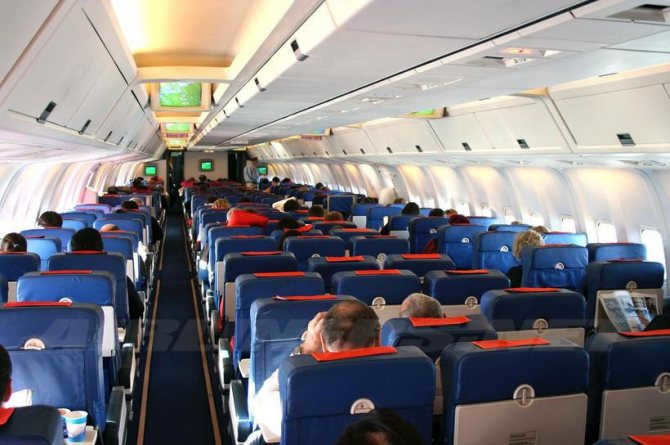


No matter if you are flying in a luxurious business class seat or squeezing yourself into a crowded economy class cabin for several hours, your body is not at its most comfortable at an altitude of 10,000 meters, and there are valid reasons for this. That’s why it’s best to abide by the saying “forewarned is forearmed”.
The art of sleep
Jetlag is a condition caused by traveling across different time zones, resulting in disrupted sleep patterns and overall poor health. It is a common issue faced by long-distance air travelers, as it disrupts their regular daily routine for a few days. One possible solution for managing jetlag is to rely on sunlight, as it is believed to help regulate sleep. For those traveling east, it is recommended to avoid direct exposure to the bright morning sun and instead spend more time outdoors in the afternoon. Conversely, for those heading west, it is advised to maximize outdoor activities during the first few days before sunset.
Is it like seasickness, but in the air?
So why does motion sickness sometimes happen to people traveling on an airplane, even though their eyes perceive the cabin as being still? In fact, even without any noticeable turbulence, some passengers may experience nausea. This is because the inner ear, which houses the vestibular apparatus, detects rocking and tilting movements within the otherwise stationary cabin and sends signals to the brain. The discrepancy between what the ear senses and what the eyes see can result in the pronounced symptoms of motion sickness. Therefore, individuals who frequently experience these symptoms should consider requesting a seat closer to the wing of the airplane, as this area tends to be the most stable part of the cabin.
Difficulty breathing
The atmosphere inside an aircraft cabin differs significantly from that found on the ground due to the multiple filters it passes through and the complete absence of moisture. Consequently, the nasal mucosa becomes dry during breathing, compromising the nose’s protective function. This makes it easier for harmful bacteria to enter the body when exposed to such air and the functioning of the nasopharynx. As a result, we often contract infections while on the plane, particularly if our immune system was weakened prior to the flight. It is common for individuals to mistakenly attribute these infections to acclimatization upon arrival.
To safeguard yourself, avoid touching your nose and eyes while on the flight – grimy hands will only facilitate the spread of infection. Consume purified water to maintain proper hydration levels in your body. Additionally, apply a moisturizing lip gloss or hygienic lipstick to prevent your lips from drying out as a result of this nasal procedure.
Embracing the Melodies
To keep themselves entertained during a flight, many passengers engage in various activities, such as watching movies or listening to music with headphones. However, one must be cautious about the potential risks associated with flying. One of the main dangers is the tendency to increase the volume in order to drown out the airplane noise, which can have a detrimental effect on the auditory nerve. While it is unlikely to go completely deaf from a single flight, frequent exposure to high volumes can lead to significant hearing impairment over time. Therefore, it is important to take breaks and prioritize ear protection, such as using earplugs, to prevent long-term damage.
—
Up in the air!
An unpleasant combination on an airplane is when passengers are immobile during the flight and the cabin pressure is low. This situation can lead to a decrease in blood flow, which may cause blood clotting in individuals with a predisposition to vascular diseases and in women who take oral contraceptives. Therefore, sitting still is the worst-case scenario. It is advisable to get up and move around the aisle at least once every hour, do squats and stretches to elongate your limbs. Don’t worry about people giving you strange looks – your health is more important!
The Stratosphere: Where Ozone Calls Home

The stratosphere is the subsequent layer of the Earth’s atmosphere. It spans from 6-20 km to 50 km above the planet’s surface. This region is where most commercial aircraft fly and where balloons traverse.
In this layer, the air does not move vertically but instead moves horizontally in rapid air currents. As you ascend, the temperature rises as a result of the abundance of natural ozone (O3), which is produced by solar radiation and oxygen. Ozone has the ability to absorb the sun’s harmful ultraviolet rays. This increase in temperature with altitude is referred to as an “inversion” in meteorology.
The stratopause, also known as the buffer layer, comes after the stratosphere.
Elevation and atmospheric characteristics
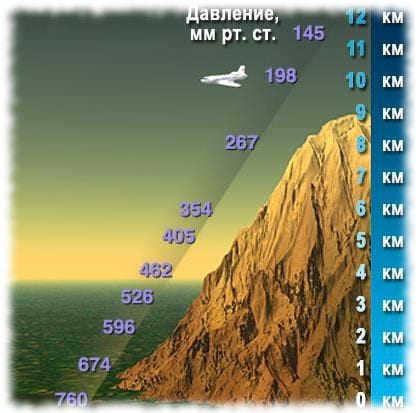
Altitude and atmospheric pressure
It is a well-known fact that at higher altitudes, the air becomes thinner. This phenomenon can be explained by a simple circumstance. The Earth’s atmosphere is held in place by its own gravitational force. This force is strongest near the surface, which allows the air to form a dense layer in the lower parts of the atmosphere. The density of the atmosphere is directly related to the pressure exerted by the higher layers. The higher the altitude, the lower the air pressure. This is similar to how pressure increases in the ocean as you go deeper due to the weight of the water above. The performance of an airplane and its ability to fly are highly dependent on the properties of the air, particularly its density.
It’s an interesting question: If diamond is considered the hardest material, what is used to process it?
Air is essential for providing lift and ensuring the normal operation of engines. It’s important to remember that without oxygen, the combustion process cannot occur and the engine will stall. While low density is not ideal, excessively high density is also not necessary. For civil aircraft, optimal conditions are typically observed at an altitude of 10 km, within the air corridor ranging from 9 to 12 km, depending on weather and other factors.
Excessive density is undesirable because it hampers the necessary speed. Dense air masses slow down the movement of an airplane in a similar way to how water slows down the movements of a swimmer. We’ve all noticed that in water, we can’t move as fast and agilely as we can on land. This is due to the higher density of water compared to air.
When civilian aircraft fly at the recommended altitude, they are able to maintain their normal speed of 800-950 km per hour without using fuel and still receive enough oxygen.
Optimal Altitude Numbers
The air density at these altitudes is sufficient to support a plane flying at the designated speed. At higher altitudes, greater speeds are necessary. For example, if a civilian plane were to fly at an altitude of 12-15 km, it would need to travel at supersonic speeds in order to stay in flight, as the air masses would not be able to sustain it otherwise.
Did you know: Is it possible to refuel a civilian airplane while it is in flight?
The current design features of commercial aircraft make this altitude ideal for their operations. However, they have the capability to fly at different altitudes if required, either slightly higher or significantly lower. Nonetheless, such deviations from the optimal altitude are not sustainable and can pose potential risks. It is the responsibility of civilian pilots to ensure the safety of the hundreds of passengers on board, and taking unnecessary risks would be irresponsible. Thus, they strictly adhere to the prescribed altitude limits, while air traffic controllers strive to provide guidance to each aircraft in the safest and most efficient manner.
Therefore, an altitude of 10 km is considered ideal for commercial airplanes due to the specific characteristics of air density and other environmental factors at this height. This particular altitude offers the most practical, cost-effective, secure, and convenient flight path for aircraft, with the exception of takeoff and landing procedures and any unforeseen circumstances such as encountering other aircraft in the same airspace, unfavorable weather conditions, or other factors that may require pilots to fly at higher or lower altitudes.
Initial experiments and inaugural achievements
The maiden voyage of the Blériot 110 took place on May 16, 1930, under the guidance of Lucien Bossoutrot, a test pilot from Blériot Aéronautique, and accompanied by engineer Filippo Zappata. The flight occurred at Bue, in close proximity to Versailles, departing from the company’s dedicated aerodrome, a customary practice for inaugural test flights of prototypes.
Naturally, due to its low-powered propulsion system and consequent lack of thrust capacity, the aircraft’s flight characteristics could not be described as exceptional: its maximum ground speed was 220 km/h, it took 1 hour to reach an altitude of 5000 meters with a load of 5300 kg, and with maximum load, its practical ceiling was 2000 meters. The required run-up length was 1200 meters. However, in spite of these limitations, the Blériot 110 was anticipated to possess unparalleled flight duration and range. Now, let us hear from Lucien Bossutro.
“When the aircraft had accumulated 150 hours of flight time, test pilot Maurice Rossi decided to take the Blériot 110 to Oran, where the weather conditions were more favorable compared to the city. Before diving into the series of record-breaking flights, it is important to understand the challenging and exhausting conditions that the pilots had to endure during the closed-loop flights. To achieve their goal, they had to complete numerous laps following a strictly defined and marked route. The daytime route stretched for 164 kilometers, while the nighttime route was 91 kilometers long, resulting in an average distance of 126 kilometers during the day. Therefore, the initial accomplishment of the Blériot 110, covering a total of 7700 kilometers, required completing sixty laps, highlighting the monotonous nature of the race.”
Consequences of Radiation: What Are the Dangers of Regular Air Travel?
Medical experts have conducted extensive research and have discovered that flight attendants are frequently diagnosed with skin and breast cancer, including melanoma. These cancer cases are directly linked to the radiation exposure experienced during air travel. Flight attendants, who spend a significant amount of time in the aircraft cabin, are exposed to the same level of radiation as passengers.
In addition to the increased risk of cancer, frequent flying can have detrimental effects on the overall functioning of the human body. The following physiological changes occur during air travel:
- The cardiovascular system experiences disruptions, leading to increased fatigue.
- The physical body experiences accelerated wear and tear.
- The cardiovascular system’s activity is disturbed.
However, there is a particular piece of information that contradicts the claims made by medical professionals regarding the impact of radiation during air travel. While it may appear that frequent flights can be detrimental due to the frequent exposure to radiation, this does not necessarily imply that one is being exposed to radiation.

Understanding the impact of radiation on an individual’s well-being
As an illustration, individuals residing in Cornwall reside in an environment where radiation levels are consistently three times higher than average due to the presence of radon. However, they remain unaffected and in good health.
In conclusion, the human body has the ability to adapt and acclimatize to new circumstances, thereby mitigating the detrimental consequences. This has been exemplified by the inhabitants of the Chernobyl zone, who have resided in the contaminated area for over three decades, cultivating their own produce without succumbing to cancer. It’s worth noting that these individuals are not young but rather senior citizens who have long surpassed the retirement age.
The examples provided above refute the claim that radiation exposure during air travel can lead to various health issues. Therefore, as long as all safety protocols are followed, even elderly individuals and pregnant women can safely embark on air travel without any threats.
Actual danger
However, there are specific circumstances where a real threat exists. Radiation can become hazardous when an airplane enters a thunderstorm, resulting in each passenger and crew member being exposed to a dose equivalent to that of a tomographic examination. While not life-threatening, this exposure can cause unpleasant symptoms such as nausea, discomfort, and mild dizziness.
In such situations, it is advisable to avoid certain medical procedures such as X-rays and MRI scans.
Additionally, solar flares can also present a potential danger.

Every 11 years, the star releases an intense level of radiation; currently, these processes are at their peak activity, resulting in a powerful coronal ejection of substances.
The planet quickly receives super-high energy rays during this time. Those who are in the atmosphere at this moment can only be pitied. They will be exposed to a significant amount of radiation.
It is impossible to predict the extent of this exposure. However, if the effects are repeated, it may lead to the development of various severe illnesses.
Currently, there is a lack of research on this phenomenon and its specific impact on humans. However, there are documented occurrences: in 2003, solar flares were observed on the Sun. Passengers on a flight from Chicago to Beijing were exposed to a radiation stream and experienced severe illness.
Typically, flights that do not pass over the polar regions are not exposed to such radiation, making them generally considered safe. However, as this incident demonstrates, it is possible during periods of heightened solar activity.
The ongoing trajectory of the Blériot 110, now named Joseph Le Brix (in honor of the pilot who lost his life in the Dewoitine D.33 accident), appeared to be in jeopardy. However, the media took an interest and the Air Ministry once again provided funding. Paul Codos took over from Lucien Bossutro as the head of testing for the Blériot 5190 Santos Dumont seaplane, and he retained Maurice Rossi, who had extensive familiarity with the Blériot 110, as part of his team.
The aircraft and its crew were given a new mission: to surpass the world record of 8796 kilometers in a straight line, which was previously achieved by the British aviators Gayford and Nicholetss. To increase their chances of success, it was decided that they would depart for the United States and then continue on to the Middle East, taking advantage of the favorable winds that blew over the North Atlantic. In June 1933, the Joseph Le Brix was flown to Le Havre and loaded onto the Champlain, a ship bound for New York. Upon arrival in the United States, Customs required the crew to pay a 500,000 francs bond as a guarantee that the airplane would leave the country successfully! Although this was an unpleasant requirement, the pilots were warmly welcomed by the Americans, even though some had doubts about the capabilities of this massive aircraft.
At Floyd Bennett airfield, where a group of mechanics were getting ready the Blériot 110, the two aviators left nothing to chance. The technicians toiled on the aircraft day and night. In order to prevent icing – de-icing systems had not yet been invented – certain surfaces of the plane were coated with a blend of lard and paraffin. As the runway was brief (only 1,250 meters), a lime mark was made 50 meters prior to the end of the runway to indicate the point where takeoff should begin. This was a futile precaution, although Kodos and Rossi had ample time to prepare for the launch: they had been waiting 41 days for favorable weather conditions to take off.
Eventually, as the sun rose on August 5, 1932, the Blériot 110 F-ALCC, carrying 6,300 liters of fuel, departed from American territory. With its nose pointed skyward, the aircraft inched along the ground at a slow pace, while Kodos gradually lifted it meter by meter to reach a suitable altitude for crossing the Atlantic Ocean. Upon reaching the coastline, the plane encountered a fierce storm. The adverse weather conditions persisted for five hours, during which the pilots took turns every 15 minutes. To make matters worse, there was also hail and carburetor icing! The engine power decreased, and the Blériot 110 found itself only two hundred meters away from the turbulent ocean. However, despite these challenges, after 30 hours of flight, Cherbourg emerged through the thick fog. While flying over Le Bourget, the plane descended to a lower altitude to release a bottle containing a note that Kodos had prepared for the journalists. This marked the first opportunity for the press to document the incredible journey of this record-breaking flight.






